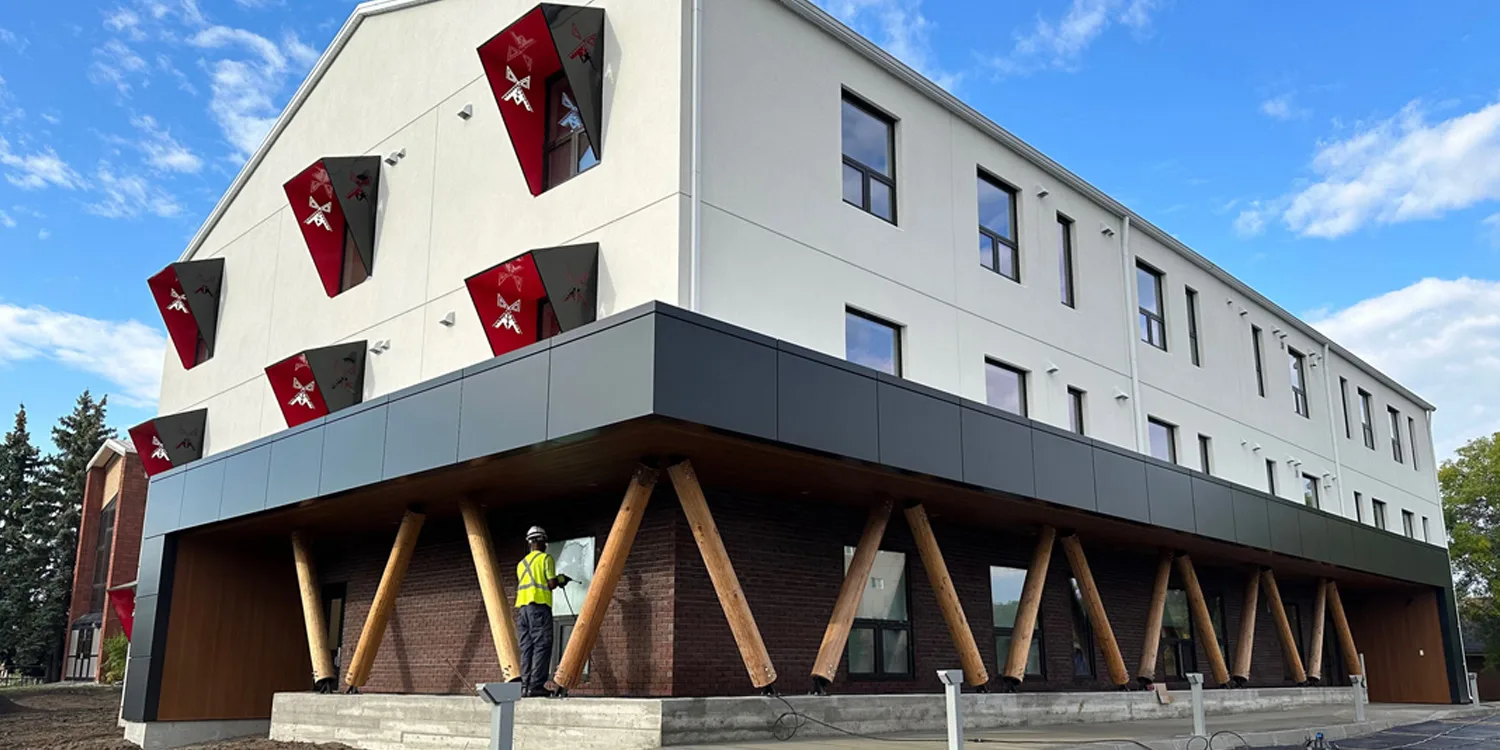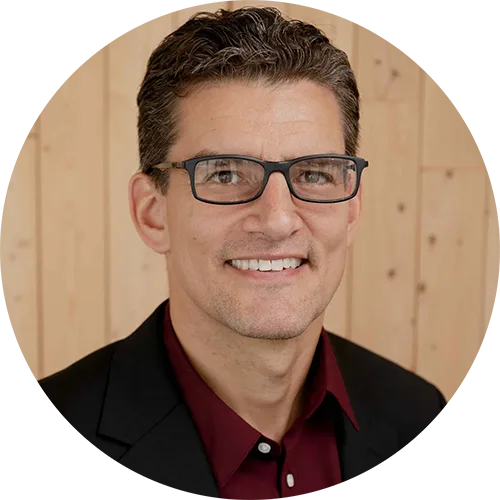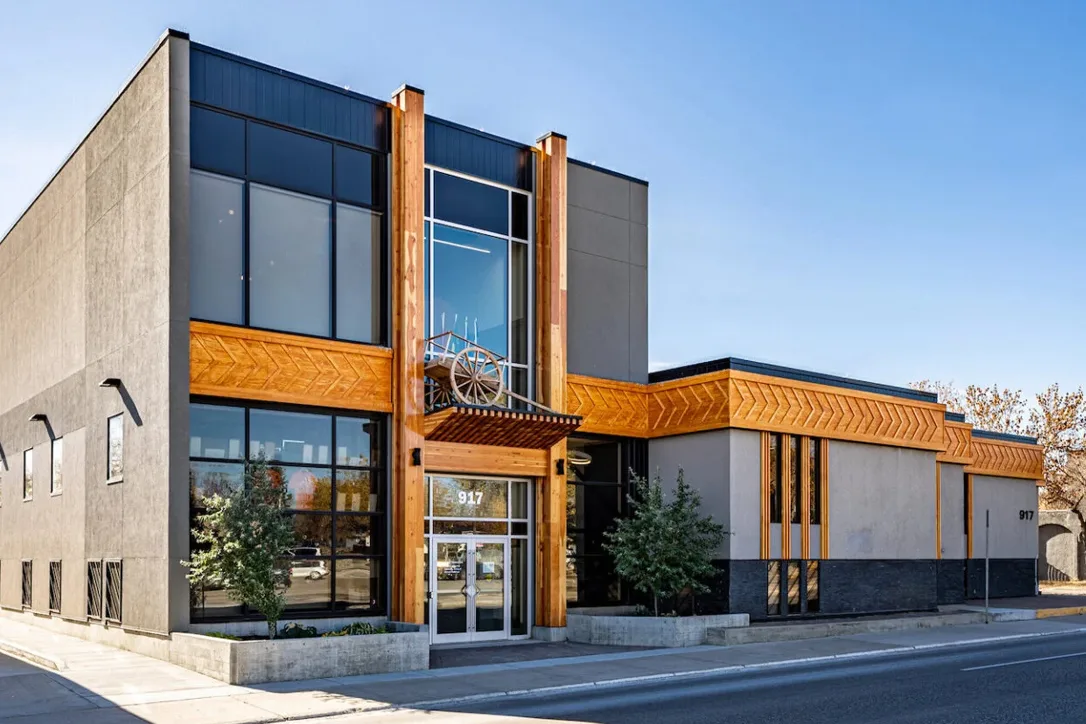Métis architect David Fortin is changing the way we think about buildings
By Jason McBride | October 24, 2025

We can’t keep building the same way, the Cambridge architect argues. “We have to come together collectively.”
David Fortin is the only person in Canada to have co-curated the country’s official entry to the Venice Biennale of Architecture twice. Those two exhibitions — 2018’s UNCEDED: Voices of the Land and 2023’s Not for Sale! — are an excellent introduction to the key themes that run through the Cambridge, Ont.-based Métis architect and professor’s work. Among them, what reconciliation means for design, how housing is commodified and how we can build more equitable and sustainable ways of living.
Central to Fortin’s thinking is the idea that many of us are alienated from the buildings that surround us. “Alienation is when the world that you’re living in — or that you’re designing in — is detached from a value system you believe in,” he says. “There’s a disconnect. And it’s not just felt in Indigenous communities.”

In his work, architect David Fortin is exploring how to build more equitable and sustainable ways of living.
The antidote, he argues, are well-designed spaces that strengthen our relations with each other and the land we live on. Such spaces are a specialty of Fortin’s. In Saskatoon, for example, he designed an elder’s lodge whose features prioritize the mental, physical and spiritual health of its residents: a ceremony room, garden with plants used in traditional medicines, sunshades on the windows decorated with Métis iconography. At the moment, his firm is part of the long-overdue revitalization of the Bissell Building at U of T and, as Fortin discusses below, building an enormous, state-of-the-art Indigenous community health centre in Hamilton.
Here, in advance of his keynote at this year’s Azure Human/Nature conference, Fortin talks about Indigenous approaches to building, the value of deep listening and the design innovations he’s most excited about.
We’re at a critical juncture for architecture: We need to build differently for a changing climate, but we also need millions of houses. How do you scale up construction while making sure it’s sustainable, affordable and speaks to the history of the land?
I’m not optimistic that you can do all of those things at one time, to be honest. The only way we can do that is through a critical investigation of the supply chains within the manufacturing process, in terms of materials sourcing and sustainable practices within that. But is that actually possible and affordable? I’ve always been skeptical of words like “urgency” and “crisis” because those words literally bring a kind of panic, and what happens? Values are moved over to address the necessary problems of the moment.
But the reality is that people need homes now. Last year we worked with the University of Waterloo and Build Now. They’re committed to building 10,000 homes in the Kitchener-Waterloo region in the next eight years. It’s a collaboration between for-profit developers, non-profit housing providers, all under the umbrella of Habitat for Humanity, who will manage the land. You can’t pit yourself against industry or developers. We don’t have time for that anymore. We have to come together collectively.
From a climate and sustainability perspective, are there older design principles — Indigenous or otherwise — that you think would be helpful to revive?
There’s still the idea that North America and Western Europe have the design solutions — that we know what we’re doing because we have thriving economies.
But if our suburban housing is perceived as a model for the world, we’re in trouble. It’s so obvious that we have the materials to build homes here in a way that would reduce carbon footprint, and be affordable. I was just at a lodge here in Ontario that was built out of straw bales. But that’s not how we think about houses anymore. It’s all wrapped up in the business side of it. Like what are your materials going to cost you? How quickly can you get it in the ground? What is your permit process and how much money do you have to pay for all of that? We’re buying products at the end of the chain, but there’s obviously better models.
How do you combat that commodification of housing?
Systemically. It’s not like the architects themselves can change all of that. But we can innovate, we can produce awareness, we can hopefully teach our students that when they’re on a project, there are choices that can be made. Overall, I think people would like to do better. It is kind of a broader cultural question. I believe the market will respond when the demand is there — where you’re going to lose a housing division if you’re not as sustainable as the next guy. We’ve reached a point where people are making decisions based on that.

David Fortin created an addition to the Gabriel Dumont Institute in Saskatoon, integrating traditional Métis detailling.
What innovations would you like to see more of?
If we’re going to build something fast, how can we at least make sure it makes sense for Mother Earth? Years ago, Eladia Smoke [an Anishinaabe architect] and I were approached by a guy who wanted to pitch us on 3D printing housing in the north because it would be quick. I’ll never forget Eladia’s response — “Can you give me a materials list of what’s in your goop? Like, what kind of chemicals and stuff?” She said, when you come back with a product that works like a termite, that takes soil and other biomaterials and spits them out and they eventually go back into the earth, then we’ll be talking about where technology and Indigenous thinking and value systems merge. The most important innovation is probably happening in this area and in biomaterials and digital technologies.
There’s also a lot of innovation happening in areas where housing is fitting into different cultural modes and urban centres. The Biindigen Well-Being Centre, the project we’re working on in Hamilton, is affordable housing, but there’s also a health centre that’s partnered with McMaster and an Indigenous health provider. There’s another building with a daycare and language teaching. And it’s all on the same site beside this huge urban farm. It’s the first project of its kind where you have three significant Indigenous organizations partnering together to basically create a small village to support their community. It’s a dream project, where all the principles are there. It’s very inspiring.
Does your approach change much when working in an Indigenous community versus a non-Indigenous one?
The initial approach doesn’t change too much. We always start from a position of deep listening. And being humble. When you’re with any community, that’s important — to prioritize their needs and goals. But when you work with Indigenous communities, the process can be entirely different. We do things that certainly weren’t taught to me in how you practice architecture. You know, share a ceremony. Always try to walk the land with community members. Spend time, hear stories, slow down that initial design. There’s always so much emphasis on the infamous sketch of the architect. But when we work with communities, that’s too presumptuous. You shouldn’t be drawing anything at all until you’ve spent meaningful time with people.
How difficult is it to apply those approaches outside of Indigenous communities?
People are very receptive. I think it’s easy for non-Indigenous people to be like, “Oh, this makes sense. And it actually makes me feel good.” Like, there’s a meaning and a purpose behind this project that transcends just making a building. There’s an elder at Laurentian University, Art Petahtegoose, who says, when we make a building, it’s not a building, it’s a community member. And we need to love and take care of it because it’s going to support and provide things for us.
Almost every major architectural project in Toronto now has an Indigenous architect or firm involved, usually partnered with a corporate or institutional firm. But in those partnerships, how much Indigenous knowledge is being brought in in a meaningful way?
There’s good stories and bad stories. We’ve all had experiences where a large or well-known firm is doing it out of obligation. But with the vast majority of people we work with, it’s very genuine. Is there exploitation? Are Indigenous peoples economically benefitting as much as they should be? I would argue not. But all we can do is be optimists and hope that it’s more of a movement and it’s going to evolve. In Toronto, there’s a lot of really meaningful stuff there — Biidaasige, the new park by the waterfront; U of T’s been doing a lot of work. I don’t think people are just paying lip service now.
David Fortin is giving the keynote address at Azure Human/Nature conference on October 29.
Photo credit: Celina Rios Nadeau (main photo), Jason Surkan (Gabriel Dumont Institute photo)
 Jason McBride
Jason McBride